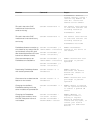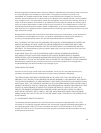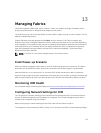
PSUs beyond those required for power and redundancy are still available and is added to the pool in the
event of a failure.
Unlike Grid redundancy, when power supply redundancy is selected, CMC does not require the PSU units
to be present in any specific PSU slot positions.
NOTE: Dynamic Power Supply Engagement (DPSE) allows PSUs to be placed in standby. The
standby state indicates a physical state of PSUs that are not supplying power. When you enable
DPSE, the extra PSUs may be placed in Standby mode to increase efficiency and save power.
Dynamic Power Supply Engagement
By default, Dynamic Power Supply Engagement (DPSE) mode is disabled. DPSE saves power by
optimizing the power efficiency of the PSUs that supply power to the chassis. This also results in
increased PSU life, and reduced heat generation. To use this feature, you must have an Enterprise
License.
CMC monitors total enclosure power allocation, and moves the PSUs into Standby state, causing the total
power allocation of the chassis to be delivered through fewer PSUs. As the online PSUs are more efficient
when running at higher utilization, it improves their efficiency and longevity of the standby PSUs.
To operate remaining PSUs at their maximum efficiency, use the following power redundancy modes:
• PSU Redundancy mode with DPSE provides power efficiency. At least two supplies are online, with
one PSU required to power the configuration, and one to provide redundancy in case of a PSU failure.
PSU Redundancy mode offers protection against the failure of any one PSU, but offers no protection
in the event of an AC grid loss.
• Grid Redundancy mode with DPSE, where at least two PSUs are active, one on each power grid. Grid
redundancy also balances the efficiency and maximum availability for a partially-loaded modular
enclosure configuration.
• Disabling DPSE provides the lowest efficiency as all four supplies are active and share the load,
resulting in lower utilization of each power supply.
DPSE can be enabled for all two power supply redundancy configurations explained above — Power
Supply Redundancy, and Grid Redundancy.
NOTE: In a two PSU configuration modes, server load may prevent any PSU from changing to the
Standby mode.
• In a Power Supply Redundancy configuration, in addition to the PSUs required to power the
enclosure, the enclosure always keeps an additional PSU powered on and marked Online. Power
utilization is monitored and one PSU can be moved to Standby state on the basis of overall system
load. In a four PSU configuration, a minimum of two PSUs are always turned on.
Because an enclosure in the Power Supply Redundancy configuration always has an extra PSU
engaged, the enclosure can accommodate the loss of one online PSU and still have enough power
for the installed server modules. The loss of the online PSU causes a standby PSU to come online.
Simultaneous failure of multiple PSUs may result in the loss of power to some server modules while
the standby PSUs are turning on.
• In Grid Redundancy configuration, all PSUs are engaged when the chassis is turned on. Power
utilization is monitored, and if system configuration and power utilization allows, PSUs are moved to
the Standby state. Because the Online status of PSUs in a grid mirrors that of the other grid, the
enclosure can sustain the loss of power to an entire grid with no interruption of power to the
enclosure.
177


















